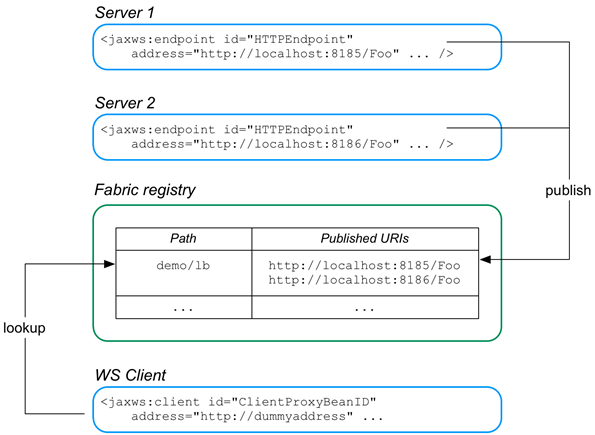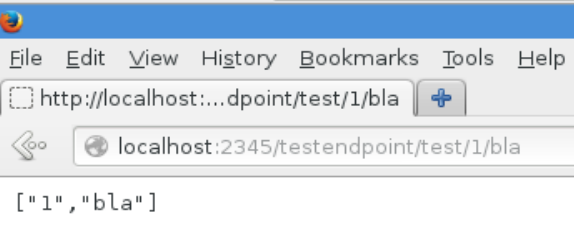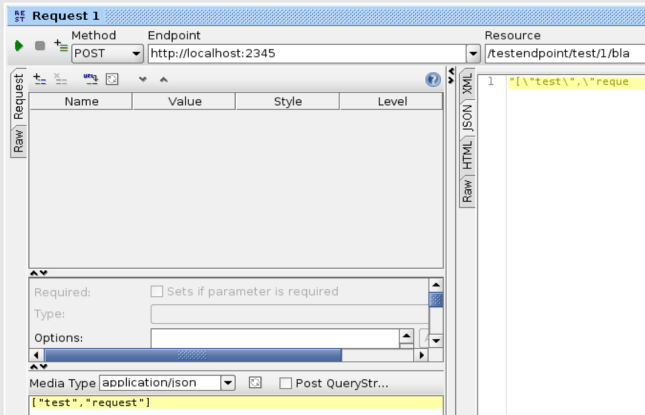In part 1 we explored the possibility to use Fabric as a load balancer for multiple CXF http endpoints and had a more detailed look at how to implement the Fabric load balancing feature on a CXFRS service. In this part we will look into the client side of the load balancer feature.
In order to leverage the Fabric load balancer from a client side clients have to be “inside the Fabric” meaning they will need access to the Zookeeper registry.
When we again take a look at a diagram explaining the load balancer feature we can see clients will need to perform a lookup in the Zookeeper registry to obtain the actual endpoints of the http service.
As mentioned in part 1 there are two possibilities to accomplish this lookup in the Fabric Zookeeper registry:
- Implement a fabric-http-gateway by assigning this profile to a container: http://fabric8.io/gitbook/gateway.html
- Build a Camel proxy
As of this moment in JBoss Fuse 6.1 the fabric-http-gateway profile is not fully supported yet. So in this post we will explore the Camel proxy route.
Camel route
A Camel proxy is essentially a Camel route
A Camel proxy is essentially a Camel route which provides a protocol bridge between “regular” http and Fabric load balancing by looking up endpoints in the Fabric (Zookeeper) registry. The Camel route itself can be very straight forward, an example Camel route implementing this proxy can look like:
<camelContext id="cxfProxyContext" trace="false" xmlns="http://camel.apache.org/schema/blueprint"> <route id="cxfProxyRoute"> <from uri="cxfrs:bean:proxyEndpoint"/> <log message="got proxy request"/> <to uri="cxfrs:bean:clientEndpoint"/> </route> </camelContext>
The Fabric load balancer will be implemented on the cxfrs:bean in the Camel route.
Note the Camel route also exposes a CXFRS endpoint in the <from endpoint therefore a regular CXFRS service class and endpoint will have to be created.
The service class is the same we used in part 1 for the service itself:
package nl.rubix.cxf.fabric.ha.test;
import javax.ws.rs.GET;
import javax.ws.rs.Path;
import javax.ws.rs.PathParam;
import javax.ws.rs.Produces;
import javax.ws.rs.core.MediaType;
@Path("/")
public class Endpoint {
@GET
@Path("/test/{id}")
@Produces(MediaType.APPLICATION_JSON)
public String getAssets(@PathParam("id") String id){
return null;
}
}
The endpoint we will expose our proxy on is configured like this:
<cxf:rsServer id=<strong>"proxyEndpoint"</strong> address=<strong>"http://localhost:1234/proxy"</strong> serviceClass=<strong>"nl.rubix.cxf.fabric.proxy.test.Endpoint"</strong>/>
Implementing the Fabric load balancer
To implement the load balancer on the client side the pom has to be updated just as the server side. Next to the regular cxfrs dependencies add the fabric-cxf dependency to the pom:
<dependency> <groupId>io.fabric8</groupId> <artifactId>fabric-cxf</artifactId> <version>1.0.0.redhat-379</version> <type>bundle</type> </dependency>
And also add the fabric cxf class to the import package in the maven-bundle-plugin to add it to the OSGi manifest file:
<plugin> <groupId>org.apache.felix</groupId> <artifactId>maven-bundle-plugin</artifactId> <version>2.3.7</version> <extensions>true</extensions> <configuration> <instructions> <Bundle-SymbolicName>cxf-fabric-proxy-test</Bundle-SymbolicName> <Private-Package>nl.rubix.cxf.fabric.proxy.test.*</Private-Package> <Import-Package>*,io.fabric8.cxf</Import-Package> </instructions> </configuration> </plugin>
The next step is to add the load balancer features to the Blueprint.xml (or Spring if you prefer Spring). These steps are similar to the configuration of the Fabric Load balancer on the Server side discussed in part 1.
So first add the cxf-core namespace to the Blueprint.xml.
xmlns:cxf-core=”http://cxf.apache.org/blueprint/core”
Add an OSGi reference to the CuratorFramework OSGi service[1]:
<reference id=<strong>"curator"</strong> interface=<strong>"org.apache.curator.framework.CuratorFramework"</strong> />
Next instantiate the load balancer bean:
Instantiate the FabricLoadBalancerFeature bean:
<bean id="fabricLoadBalancerFeature" class="io.fabric8.cxf.FabricLoadBalancerFeature"> <property name="curator" ref="curator" /> <property name="fabricPath" value="cxf/endpoints" /> </bean>
It is important to note the value in the “fabricPath” property must contain the exact same value of the fabricPath of the service the client will invoke. This fabricPath points to the location in the Fabric Zookeeper registry where the endpoints are stored. It is the coupling between the client and service.
To register the Fabric load balancer with the cxfrs:bean used in the to endpoint (we are implementing a client so we must register the Fabric load balancer with the cxfrs bean on the client side). Extend the declaration of the cxfrsclient:
<cxf:rsClient id="clientEndpoint" address="http://dummy/url" serviceClass="nl.rubix.cxf.fabric.proxy.test.Endpoint"> <cxf:features> <ref component-id="fabricLoadBalancerFeature"/> </cxf:features> </cxf:rsClient>
Add the Fabric load balancer feature to a cxf bus in the rsClient:
<cxf:rsClient id="clientEndpoint" address="http://dummy/url" serviceClass="nl.rubix.cxf.fabric.proxy.test.Endpoint"> <cxf:features> <ref component-id="fabricLoadBalancerFeature"/> </cxf:features> </cxf:rsClient>
The entire Blueprint.xml for this proxy looks like this:
<?xml version="1.0" encoding="UTF-8"?> <blueprint xmlns="http://www.osgi.org/xmlns/blueprint/v1.0.0" xmlns:xsi="http://www.w3.org/2001/XMLSchema-instance" xmlns:camel="http://camel.apache.org/schema/blueprint" xmlns:cxf="http://camel.apache.org/schema/blueprint/cxf" xmlns:cxf-core="http://cxf.apache.org/blueprint/core" xsi:schemaLocation=" http://www.osgi.org/xmlns/blueprint/v1.0.0 http://www.osgi.org/xmlns/blueprint/v1.0.0/blueprint.xsd http://camel.apache.org/schema/blueprint http://camel.apache.org/schema/blueprint/camel-blueprint.xsd"> <cxf:rsServer id="proxyEndpoint" address="http://localhost:1234/proxy" serviceClass="nl.rubix.cxf.fabric.proxy.test.Endpoint"/> <cxf:rsClient id="clientEndpoint" address="http://dummy/url" serviceClass="nl.rubix.cxf.fabric.proxy.test.Endpoint"> <cxf:features> <ref component-id="fabricLoadBalancerFeature"/> </cxf:features> </cxf:rsClient> <reference id="curator" interface="org.apache.curator.framework.CuratorFramework" /> <bean id="fabricLoadBalancerFeature" class="io.fabric8.cxf.FabricLoadBalancerFeature"> <property name="curator" ref="curator" /> <property name="fabricPath" value="cxf/endpoints" /> </bean> <camelContext id="cxfProxyContext" trace="false" xmlns="http://camel.apache.org/schema/blueprint"> <route id="cxfProxyRoute"> <from uri="cxfrs:bean:proxyEndpoint"/> <log message="got proxy request"/> <to uri="cxfrs:bean:clientEndpoint"/> </route> </camelContext> </blueprint>
This Camel proxy will proxy request from: “http://localhost:1234/proxy” to the two instances of the CXFRS service we created in part 1 running on port “http://localhost:2345/testendpoint”
When we deploy this Camel proxy in a Fabric profile and run it in a Fabric container we can test the proxy:
The response comes from the service created in part 1, but now it is accessible by our proxy endpoint.
Abstracting endpoints like this makes sense in larger Fabric environments when leveraging multiple machines hosting the Fabric containers. Clients no longer need to know the IP and port of the services they call. So scaling and migrating the services to other machines becomes much easier. For instance adding another instance of a CXFRS service on a container running on another machine, or even in the cloud no longer requires the endpoints of the clients to be updated.
For more information about CXF load balancing using Fabric:
[1] The CuratorFramework service is for communicating with the Apache Zookeeper registry used by Fabric.





